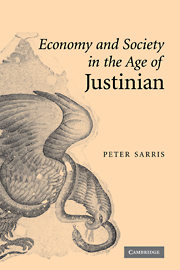Book contents
- Frontmatter
- Contents
- List of figures
- Preface
- Introduction
- 1 Egypt and the political economy of empire
- 2 The Apion archive: economic structure and estate accounts
- 3 Labour and administration: the evidence of the contractual papyri
- 4 Letters and petitions: social relations in the sixth-century Oxyrhynchite
- 5 The Apiones and their analogues
- 6 On the margins of magnate power: Dioscorus and Aphrodito
- 7 Landscapes of power: the great estate beyond Egypt
- 8 The historiography of the great estate
- 9 The great estate and the imperial authorities
- 10 The rise of the great estate
- 11 Economy and society in the age of Justinian
- Conclusion
- Bibliography
- Index
Conclusion
Published online by Cambridge University Press: 24 July 2009
- Frontmatter
- Contents
- List of figures
- Preface
- Introduction
- 1 Egypt and the political economy of empire
- 2 The Apion archive: economic structure and estate accounts
- 3 Labour and administration: the evidence of the contractual papyri
- 4 Letters and petitions: social relations in the sixth-century Oxyrhynchite
- 5 The Apiones and their analogues
- 6 On the margins of magnate power: Dioscorus and Aphrodito
- 7 Landscapes of power: the great estate beyond Egypt
- 8 The historiography of the great estate
- 9 The great estate and the imperial authorities
- 10 The rise of the great estate
- 11 Economy and society in the age of Justinian
- Conclusion
- Bibliography
- Index
Summary
This study opened with two objectives. The first was to attempt to build up a social and economic context in which to situate the reign of the Emperor Justinian; the second was to consider the implications of the empire's pattern of social and economic development under Justinian for its subsequent post-Justinianic history.
Justinian's reform programme, as we have seen, effectively sought to stem the tide of over two centuries of social development within the Eastern Empire. The political and administrative reforms by which the Roman Empire had overcome the military and economic crises of the third century had, in the fourth, catalysed a dynamic process of elite formation across the Mediterranean world as a whole. By virtue of this process, a new imperial aristocracy of service had come to dominate provincial landed society. In many ways, members of this new elite helped to bind the empire together, providing a nexus and point of contact between the world of the court and the world of the provinces. At the same time, the highly monetised bipartite great estates from which its members typically derived much of their private income bolstered and sustained economic growth. But at a more insidious level, the consolidation of this new elite's social and economic preponderance threatened to undermine the basis of empire, for members of the aristocracy of service were uniquely placed, by virtue of their social authority and the political positions that they held, to engage in acts of large-scale tax evasion and thereby to interrupt and diminish the flow of tax revenues on which the structures of the Roman state and, above all, the Roman army depended.
- Type
- Chapter
- Information
- Economy and Society in the Age of Justinian , pp. 228 - 234Publisher: Cambridge University PressPrint publication year: 2006

